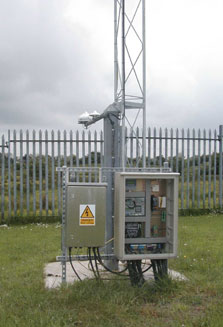| 2003 |

|
YEAR BOOK |
Met �ireann
|
The TUCSON Automatic Weather Station
|
Some years ago, Met �ireann decided to develop an automatic weather station (AWS) which would be capable of carrying out both synoptic and climatological weather observations. Synoptic observations are detailed, real-time measurements of air pressure, wind speed and direction, temperature, dew point etc., needed for immediate analysis and forecasting of the current weather situation. Climatological observations focus on a smaller number of weather elements - typically rainfall and temperature - and serve mainly to describe local weather patterns and their variation over longer time periods.
Currently, Met �ireann maintains a network of 16 synoptic weather stations and approximately 80 climate stations. While the synoptic network is a mix of manual and automatic stations, the climatological network is almost entirely manual. In developing the new automatic station, Met �ireann aimed to enhance the quality and quantity of observations from both networks. To reflect its dual synoptic and climatological application, the development project was named TUCSON - The Unified Climate and Synoptic Observation Network.

By mid-2002, a prototype system had been developed and was ready for field testing. A fully-functional TUCSON AWS was installed at Met �ireann's weather station at Mullingar, and has operated very reliably - no data have been lost and the TUCSON measurements have correlated well with the official Mullingar readings.
The list of weather elements which can be measured by TUCSON includes atmospheric pressure, wind speed and direction, precipitation amount, air temperature, relative humidity, solar radiation, grass minimum temperature and a range of soil and earth temperatures. The sensors which measure these elements are wired to the data logger, which is programmed using Campbell Scientific's EDLOG software.
Most sensors in the TUCSON system are duplicated, providing resilience and also a means of data quality control. Once measured, data are processed on the local logger. A modem connection provides for the automatic transmission of data to Met �ireann's communications centre in Dublin. There they are further quality controlled and formatted for use in the operational forecast offices, for onward international circulation and for archiving in the climate databases.
At present there are TUCSON stations installed at four locations - Mullingar, Co. Westmeath; Phoenix Park, Dublin; Mace Head, Co. Galway; and Johnstown Castle, Co. Wexford.
It is planned to install approximately 25 additional stations over the coming five years. This will represent a very substantial enhancement of Met �ireann's observational network, and provide an invaluable data resource for operational weather forecasting, climate and environmental monitoring, and the development of customised services for specialised applications - for example, in the agricultural sector.
Contact: David Fitzgerald,
Instrumentation and Environmental Monitoring Division,
Met �ireann, Glasnevin Hill, Dublin 9.
E-mail: [email protected]